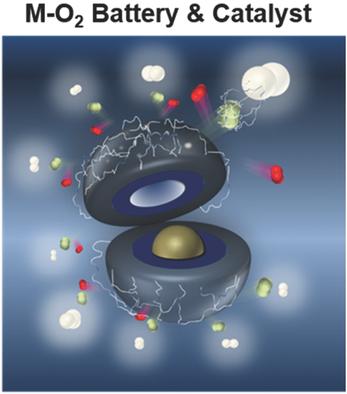当前位置:
X-MOL 学术
›
Adv. Mater.
›
论文详情
Our official English website, www.x-mol.net, welcomes your feedback! (Note: you will need to create a separate account there.)
High‐Energy‐Density Metal–Oxygen Batteries: Lithium–Oxygen Batteries vs Sodium–Oxygen Batteries
Advanced Materials ( IF 29.4 ) Pub Date : 2017-09-21 , DOI: 10.1002/adma.201606572 Kyeongse Song 1 , Daniel Adjei Agyeman 1 , Mihui Park 1 , Junghoon Yang 1 , Yong-Mook Kang 1
Advanced Materials ( IF 29.4 ) Pub Date : 2017-09-21 , DOI: 10.1002/adma.201606572 Kyeongse Song 1 , Daniel Adjei Agyeman 1 , Mihui Park 1 , Junghoon Yang 1 , Yong-Mook Kang 1
Affiliation

|
The development of next‐generation energy‐storage devices with high power, high energy density, and safety is critical for the success of large‐scale energy‐storage systems (ESSs), such as electric vehicles. Rechargeable sodium–oxygen (Na–O2) batteries offer a new and promising opportunity for low‐cost, high‐energy‐density, and relatively efficient electrochemical systems. Although the specific energy density of the Na–O2 battery is lower than that of the lithium–oxygen (Li–O2) battery, the abundance and low cost of sodium resources offer major advantages for its practical application in the near future. However, little has so far been reported regarding the cell chemistry, to explain the rate‐limiting parameters and the corresponding low round‐trip efficiency and cycle degradation. Consequently, an elucidation of the reaction mechanism is needed for both lithium–oxygen and sodium–oxygen cells. An in‐depth understanding of the differences and similarities between Li–O2 and Na–O2 battery systems, in terms of thermodynamics and a structural viewpoint, will be meaningful to promote the development of advanced metal–oxygen batteries. State‐of‐the‐art battery design principles for high‐energy‐density lithium–oxygen and sodium–oxygen batteries are thus reviewed in depth here. Major drawbacks, reaction mechanisms, and recent strategies to improve performance are also summarized.
中文翻译:

高能量密度金属氧电池:锂氧电池与钠氧电池
具有高功率,高能量密度和安全性的下一代储能设备的开发对于电动汽车等大型储能系统(ESS)的成功至关重要。可充电的钠氧(Na-O 2)电池为低成本,高能量密度和相对高效的电化学系统提供了新的有希望的机会。尽管Na–O 2电池的比能量密度低于锂氧(Li–O 2)的比能量密度)电池,钠资源丰富且成本低廉,为其在不久的将来的实际应用提供了主要优势。然而,到目前为止,关于细胞化学的报道很少,无法解释限速参数以及相应的低往返效率和循环降解。因此,锂氧电池和钠氧电池都需要阐明反应机理。深入了解Li–O 2和Na–O 2之间的异同电池系统,从热力学和结构观点来看,对于促进先进的金属-氧气电池的发展将是有意义的。因此,本文将对高能量密度锂氧电池和钠氧电池的最新电池设计原理进行深入探讨。还总结了主要的缺点,反应机理和提高性能的最新策略。
更新日期:2017-09-21
中文翻译:

高能量密度金属氧电池:锂氧电池与钠氧电池
具有高功率,高能量密度和安全性的下一代储能设备的开发对于电动汽车等大型储能系统(ESS)的成功至关重要。可充电的钠氧(Na-O 2)电池为低成本,高能量密度和相对高效的电化学系统提供了新的有希望的机会。尽管Na–O 2电池的比能量密度低于锂氧(Li–O 2)的比能量密度)电池,钠资源丰富且成本低廉,为其在不久的将来的实际应用提供了主要优势。然而,到目前为止,关于细胞化学的报道很少,无法解释限速参数以及相应的低往返效率和循环降解。因此,锂氧电池和钠氧电池都需要阐明反应机理。深入了解Li–O 2和Na–O 2之间的异同电池系统,从热力学和结构观点来看,对于促进先进的金属-氧气电池的发展将是有意义的。因此,本文将对高能量密度锂氧电池和钠氧电池的最新电池设计原理进行深入探讨。还总结了主要的缺点,反应机理和提高性能的最新策略。

























 京公网安备 11010802027423号
京公网安备 11010802027423号